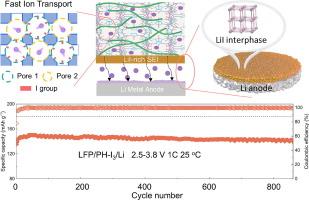双通道MOF实现高通量Li+传导和原位富锂SEI,用于高性能固态锂金属电池
IF 14.9
1区 化学
Q1 Energy
引用次数: 0
摘要
固态锂金属电池(sslmb)面临着枝晶生长和界面不稳定的严峻挑战。虽然复合聚合物电解质(cpe)很有前途,但离子电导率差(<10−5 S cm−1),Li+转移数低(tLi+ < 0.5),界面稳定性不足,限制了其实际应用。在此,我们设计了一种基于双通道金属有机框架(MOF)的cpe,它可以同时调节离子传输并构建高导电性的间相。该MOF具有两个不同的通道。一种是施加空间限制(孔径0.57 nm)来抑制阴离子迁移(TFSI -),而另一种是通过碘介导的亲核取代来固定化TFSI -。更重要的是,释放的I−与Li+反应,原位生成碘化锂(LiI)增强的固体电解质界面(SEI),取代绝缘的富liff对应物。这种Li - sei表现出优异的离子电导率和均匀的Li+通量来抑制枝晶。MOF CPE集成到聚偏氟乙烯-六氟丙烯(PVDF-HFP)基体中,具有优异的离子电导率(2.13×10 - 4 S cm - 1)和0.95(25°C)的高tLi+。密度泛函理论和分子动力学计算验证离子调节机制。结果表明,LiFePO4//Li电池在800次循环(1℃)后仍能保持94.99%的容量,而NCM811//Li电池在200次循环后仍能保持稳定。这项工作为高性能sslmb的多功能MOF离子导体的设计提供了有价值的见解。本文章由计算机程序翻译,如有差异,请以英文原文为准。

Dual-channel MOF enabling high-flux Li+ conduction and in situ LiI-rich SEI for high-performance solid-state lithium metal batteries
Solid-state lithium metal batteries (SSLMBs) face critical challenges from dendrite growth and unstable interfaces. While composite polymer electrolytes (CPEs) offer promise, poor ionic conductivity (<10−5 S cm−1), low Li+ transference numbers (tLi+ < 0.5), and inadequate interfacial stability limit practical application. Herein, we design a dual-channel metal-organic framework (MOF)-based CPEs that simultaneously regulate ion transport and construct a high-conductivity interphase. This MOF features two distinct channels. The one imposes spatial confinement (0.57 nm in pore size) to suppress anion migration (TFSI−), while the other facilitates immobilizing TFSI− through iodine-mediated nucleophilic substitution. More importantly, the liberated I− reacts with Li+ to in situ generate lithium iodide (LiI)-enhanced solid-electrolyte interphase (SEI), replacing insulating LiF-rich counterparts. This LiI-SEI exhibits superior ionic conductivity and homogenizes Li+ flux to suppress dendrites. Integrated into a poly(vinylidene fluoride)-cohexafluoropropylene (PVDF-HFP) matrix, the MOF CPE achieves exceptional ionic conductivity (2.13×10−4 S cm−1) and a high tLi+ of 0.95 (25 °C). Density functional theory and molecular dynamics calculations verify ion-regulation mechanisms. As a result, LiFePO4//Li cells retain 94.99% capacity after 800 cycles (1 C), while NCM811//Li cells demonstrate sustained stability over 200 cycles. This work provides valuable insights into the design of multifunctional MOF ionic conductors for high-performance SSLMBs.
求助全文
通过发布文献求助,成功后即可免费获取论文全文。
去求助
来源期刊

Journal of Energy Chemistry
CHEMISTRY, APPLIED-CHEMISTRY, PHYSICAL
CiteScore
19.10
自引率
8.40%
发文量
3631
审稿时长
15 days
期刊介绍:
The Journal of Energy Chemistry, the official publication of Science Press and the Dalian Institute of Chemical Physics, Chinese Academy of Sciences, serves as a platform for reporting creative research and innovative applications in energy chemistry. It mainly reports on creative researches and innovative applications of chemical conversions of fossil energy, carbon dioxide, electrochemical energy and hydrogen energy, as well as the conversions of biomass and solar energy related with chemical issues to promote academic exchanges in the field of energy chemistry and to accelerate the exploration, research and development of energy science and technologies.
This journal focuses on original research papers covering various topics within energy chemistry worldwide, including:
Optimized utilization of fossil energy
Hydrogen energy
Conversion and storage of electrochemical energy
Capture, storage, and chemical conversion of carbon dioxide
Materials and nanotechnologies for energy conversion and storage
Chemistry in biomass conversion
Chemistry in the utilization of solar energy
 求助内容:
求助内容: 应助结果提醒方式:
应助结果提醒方式:


